
Miniature
Orchids – Good Things Come In Small Packages
By Dr Cordelia Head - J & L Orchids - USA
Orchid lovers looking for more variety will find unending fascination
and beauty in miniature orchids. Small, compact plants far outnumber
the large kinds. In an area required for half a dozen large orchids,
dozens of miniatures may be grown. They are ideal for growers with limited
space, such as apartment dwellers or home owners with no greenhouse.
Even those fortunate to have a greenhouse soon run out of room and miniatures
can fill many an empty niche.
Miniature orchids are very appealing in a variety of ways, such as plant
shape, colors, and weird unusual flowers. Their growth habit can range
from the little grass-like tufts of Trisetella triglochin to
the beautifully patterned leaves of Lepanthes calodictyon. They
can cover a pot with moss-like growth like Barbrodria miersii or
trickle over a branch with chains of leaves, as in Lepanthes pilosella.
Some miniatures, like the genus Chilochista, are completely leafless
and consist of only a twisted nest of silver roots, others have thick,
succulent leaves that clasp and wrap around a branch, as in Sophronitis
cernua.
Orchids are known for their beautiful array of color and miniatures
have every possible range and combination. The brilliant fluorescent
pink and red of Masdevallia eumeliae or the vivid white, orange
and yellow of Dendrobium bellatulum are just two examples. Miniatures
have a fantastic array of flower shapes, triangles with long twisted
tails, bowl-shaped flowers lined with hairs and knobby purple flowers
trimmed with white fringe. They can bloom in a flush of hundreds of
flowers or bloom several times a year. Many miniatures are fragrant,
some strongly, others more delicately. Pleurothallis pterophora with
its attractive spotted paddle-shaped leaves, twice a year blooming habit,
crystalline white flowers and heavenly fragrance typifies what makes
miniatures a joy and delight to grow for all orchid lovers.

Diversity
and threats on orchid’s resources from Guadeloupe, West Indies
By Philippe Feldmann - France

Map and photo by P Feldmann |
Improvement
of Guadeloupe’s orchids knowledges on diversity, populations
mapping and threats was developed in order to better evaluate
wealth of this family and to develop bioindicators.
This allows to follow the evolution of natural ecosystems and
their threats. Information available in the literature and in
herbarium has been compiled and compared with the data having
been collected for 15 years of field work. 93 species have been
reported recently from Guadeloupe in the wild including five of
them strictly endemics, making Guadeloupe the most important and
rich island in the Lesser Antilles. Nine other species
|
have not been reported for years. Populations mapping analysis and recent
reported evolution lead to classify 10 species as threatened following
IUCN criteria. Threats can be linked to natural cataclysms but resulted
mostly from human activities. Available knowledges give basic information
useful for the implementation of continuous survey of the wild populations.
Therefore, the possibly necessary conservatory measures could be proposed.
Philippe
Feldmann is the Associate Director of Research for Biological Resources
at the Office of the Direction of Research - Montpellier - France

The
Venezuelan Tepuis
By Jean-Michel HERVOUET - France
The lecture will present an Orchid-spotting field trip in the state
of Bolivar, Venezuela, where about one hundred high plateaus, locally
known as Tepuis, are scattered over the so-called « Gran Sabana
» savannah area. These remote Tepuis have inspired Sir Arthur
Conan Doyle, who depicted one of them being haunted by surviving Iguanodons
and Pterodactyls in his novel « the Lost World ». The highest
Tepui is Mount Roraïma, reaching 2,810 m at its highest point.
It is surrounded by 600 m high vertical cliffs. The presentation will
mostly deal with an exploration of that Mount Roraïma, a 8-day
hike including the approach way, the ascent to the summit and a survey
of the top. The largest Tepui, the Auyantepui, spreads over 700 km2.
After a flight in a small plane, we will sail up the Carrao and Churun
rivers, to search after Orchids around the bottom of Salto Angel, the
highest waterfall in the world, which rushes down from the top of Auyantepui.
Jean-Michel
HERVOUET is the vice-president of the SFO (Société Française
d’Orchidophilie) and has published about 20 reports of travels
all over the world in the journal « L’Orchidophile ».

New
Observations on the Orchid Flora of Madagascar.
By Johan Hermans - England
The Indian Ocean Island of Madagascar is the fourth largest island in
the world and was separated from the mainland many millions of years
ago and in this way developed a very specialised, largely endemic flora
and fauna. The country has a remarkable variety of vegetation zones,
going from tropical rainforest through cool and fertile highlands to
virtual desert.
Many interesting new discoveries and observations have been made on
the orchid flora of Madagascar during the last decade, many of these
findings are of direct interest to people who are growing or studying
plants from the area.
A general introduction will be given to the different climate zones
and habitats of the Island. Not only will this illustrate the stunning
scenery and extraordinary fauna and flora, but it will also provide
useful information on how to grow some of the orchids in cultivation.
Observation of plants in the field and in cultivation, combined with
study of herbarium specimens has provided new thoughts on the taxonomy
of several groups. Some of these changes will be discussed and illustrated;
there will be special emphasis on horticulturally important genera like
Angraecum, Cynorkis, Eulophia and Gastrorchis.
Analysis of the distribution patterns of key species has produced results
that are directly relevant to their conservation; a summary of findings
will be presented. Several very unusual species are now being propagated
and they will hopefully become available to amateur orchid growers in
the near future, some of the more fascinating new introductions will
be discussed.
Johan Hermans has been studying the orchid flora of Madagascar for the
last 15 years, he has visited the Island frequently. He has authored
a number of popular articles and, in collaboration with Dr. Phillip
Cribb and Mr. Jean Bosser, has published several taxonomic papers and
books on the subject.
| |
Photo
by J Hermans |
| |
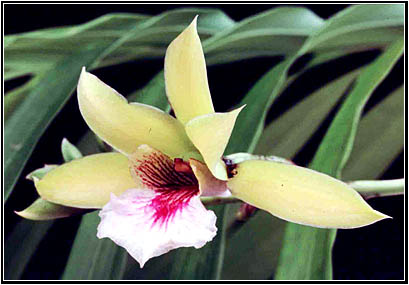
Paralophia
epiphytica from Madagascar. Now almost extinct in nature
but grown succesfully from seed in cultivation |
Johan
is an Honorary Research Associate of the Royal Botanic Gardens Kew,
vice-chairman of the Royal Horticultural Society Orchid Committee and
a Fellow of the Linnean Society.

Ida,
spectacular orchids from South America, their natural habitat and culture
By Dr Henry F. Oakeley
These orchids have been in the genus Maxillaria and then in Lycaste.
The lecture describes why they have been put into a new genus, Ida,
with a simple account of the DNA work and the differences in flower
structure which made it necessary. Photos of many of these plants in
flower, both in the greenhouse and in their natural habitat, with spectacular
views of the Andes and the cloud forests, will be shown. From this a
clear explanation of how to grow them will be given and the conditions
necessary in the greenhouse. At the end of the lecture you should be
able to look at an Ida plant and, even if it is not in flower and without
a name, to tell the conditions in which it should be grown. The story
of the plants and their discovery, of the chaos that has surrounded
their identification will be related. It was for good reasons that H.G.
Reichenbach wrote that the study of these orchids was as much fun as
stroking hedgehogs, but time has passed and they can now give much pleasure.
Dr Henry
Oakeley is expert in Lycaste, Anguloa and Ida and has
been growing them for 49 years. He does some writing, lecturing, breeding,
photography, making herbarium specimens (for 55 years) and drawings.
He travels a lot and sits on numerous committees. He is Trustee of the
World Orchid Conference Trust.

Orchids
of New Guinea
By Andre Schuiteman - National Herbarium Nederland
 |
The
huge island of New Guinea undoubtedly has the richest orchid flora
within the old world tropics, with perhaps as many as 2800 species.
About 95% of the species are endemic, a far higher percentage
than in any other area in the Asia-Pacific region. In contrast,
there are only a few endemic genera or sections of genera in New
Guinea. Many more genera or sections, however, probably originated
in New Guinea and dispersed to neighbouring areas and beyond.
The climate in large parts of New Guinea is highly favourable
for the growth of epiphytes (80% of the orchid flora consists
of epiphytes), while the numerous and rugged mountain ranges create
an extremely varied topography. These factors at least partly
explain the extraordinary orchid diversity in New Guinea. At the
same time, and somewhat unexpectedly, it appears that most species
are fairly widespread within the island.
We know very little about the ecology of most New Guinea orchids,
in particular of their pollination mechanisms.
It
would seem that compared to other areas in the old world tropics
New Guinea has a far higher proportion of bird-pollinated orchid
species. Several species of the genus Bulbophyllum possess
such unusual flowers that it is hard to predict how they are pollinated.
Many surprises await the patient investigator.
|
André Schuiteman is currently a staff member of the National
Herbarium of the Netherlands and the main author of the CD-ROM series
Flora Malesiana: Orchids of New Guinea. He visited Tanzania, Colombia,
Malaysia, Indonesia and Papua New Guinea to study the local orchid flora.

Stanhopeinae,
An Old Subtribe in New Light
By Rudolf Jenny - Switzerland
Molecular taxonomy has shown that several genera earlier treated as
members of the subtribe Stanhopeinae should be separated as own
subtribe (Coeliopsidinae). Beside this the existent delineations
of the remaining genera are clearly confirmed. Many new species have
been described in the last 10 years, especially from genera like Coryanthes,
Paphinia, Polycycnis and Gongora. Some of those
new species were known from cultivated or dried specimens under wrong
names for many years, some others have been collected for the first
time. In general it is a problem to get enough material of such fresh
collected plants to decide whether it is a new species or only a variation
of a known one, quite a number of those new species is defined based
on single plants. Some genera like Cirrhaea, Acineta and
Polycynis are in need of a monographic treatment, again the major
problem is the lack of sufficient material, combined with incomplete
data about distribution.
photos
by R Jenny
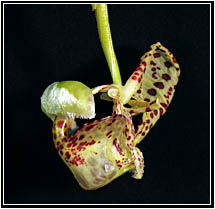
Coryanthes seegeri |
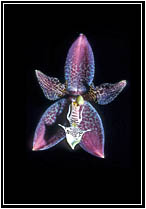
Houlletia lansbergii |
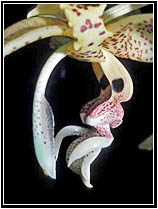 Stanhopea dodsoniana
Stanhopea dodsoniana |
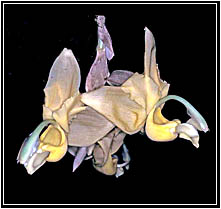
Stanhopea maduroi |

Stanhopea marizaiana |

Stanhopea schilleriana |
Rudolf
Jenny, chemist by training, working with Orchids since more than 30
years, especially interested and active in the subtribes Pleurothallidinae,
Catasetinae and Stanhopeinae. Author of monographs of
Gongora, Sievekingia and Stanhopea. Author of the
worldwide most comprehensive database about Orchid literature BIBLIORCHIDEA.

Comparative
analysis between Orchis species and their hybrid
Bertrand Schatz - Centre d’Ecologie Fonctionnelle et Evolutive
(CEFE), Montpellier
Hybridization
is commonly regarded as one of the leading mechanisms in plant evolution.
Its widespread occurrence within Orchidaceae suggests that it may play
a significant role in orchid speciation and in their evolution. Ecological
observations and studies of odours emitted by plants can yield information
on the causes and consequences of hybridization. We studied the parental
species Orchis simia and O. anthropophora and their hybrid
O. bergonii in the region of “Grands Causses” north
of Montpellier, France. We compared floral morphology, the suite of
flower visitors and (using head-space technique) the volatile compounds
emitted by flowers of the three taxa. Hybrids were intermediate in floral
morphology between their two parents. We distinguished among confirmed
pollinators, potential pollinators and non-pollinating among insects
observed on the inflorescences. One species of beetle was a confirmed
pollinator of the two parental species. Interestingly, the habitat in
which the hybrid occurs is also that in which this beetle occurs. The
volatile compounds emitted by O. bergonii were quantitatively
very different from those emitted by O. simia and O. anthropophora.
This difference can explain why only few insects were observed on the
inflorescences of hybrids, whereas insects were more numerous on inflorescences
of the two parental species. This case then constitutes a promising
model for understanding the ecology of pollination in hybrid orchids.
Bertrand Schatz is a young researcher in the French CNRS, where he investigates
several insects-orchids interactions in the Mediterranean region. He
is in charge of the scientific commission “Insects-orchids interactions”
of SFO (French Society of Orchidophily).

9) Orchids
and the biogeography of Sulawesi
Jaap Jan Vermeulen - Singapore Botanic Gardens
Around
1850, Edgar Wallace traveled widely in Malaysia and Indonesia, collecting
animals to sell to museums in Europe. In 1858 he wrote in a letter to
Charles Darwin that he had observed that the composition of the local
fauna changed abruptly when crossing a line running North and West of
Sulawesi, and continuing southwards to pass West of Lombok. This Wallace
Line, as it later became known, is the boundary between two major faunistic
realms: the Asian realm in the North, and the Australian-Pacific realm
in the South. In order to explain this boundary, he assumed that large-scale
changes in the distribution of land and sea had occurred in geological
history, as a result of underground movements. This was deemed unlikely
by his contemporaries but, over a century later, became the established
view, known as continental drift.
Wallace also found that the Sulawesi fauna included elements of both
North and South. Later, more precise analysis of the flora of Sulawesi
found a predominance of species of Southern (New Guinean) origin in
the lowlands, and of Northern origin (Borneo) in the mountains.
Orchids may not be perfect organisms for study if one wishes to analyze
patterns of biogeography. Their fine seeds enable them to spread quickly,
obliterating distributional patterns that reveal their biogeographical
history. But surely orchids follow the general pattern: Sulawesi is
one of the few places where Glomera, Epiblastus, and Mediocalcar
(all genera predominantly Southern) can be found on one tree growing
together with Aerides, Dendrochilum, and Pteroceras (all predominantly
Northern). However, what makes the Sulawesi orchid flora truly unique
is the large number of endemics. These have evolved because of a general
geological instability of the area. The compression resulting from the,
geologically speaking, recent collision of the land masses forming the
various parts of the island, have caused the formation of new mountain
chains, that locally rise over 3000 m above sea level. Survival in these
changing environments required adaptation, resulting in speciation.
Another factor is undoubtedly the extremely varied geology, including
large tracts of land on ultrabasic bedrock, a rare rock type on a worldwide
scale, derived from old ocean floor. A low water retention capacity,
extreme infertility and high levels of toxic metals characterize soils
derived from such bedrock. Here, too, environmental strain has led to
speciation. Examples are Spathoglottis tricallosa and Bulbophyllum univenum,
both terrestrial species that are entirely restricted to this environment.
Jaap J. Vermeulen is Taxonomist and botanical/zoological artist, specializing
in orchids and terrestrial mollusks, author of numerous papers on the
genus Bulbophyllum. He wrote a revision of the continental African
Bulbophyllum species. He is PhD in orchid taxonomy. At present
he is employed by Singapore Botanic Gardens, as an orchid taxonomist
(Senior Research Officer).

The
Genus Lepanthes
By Dr Moises Behar
Lepanthes are small epiphytic plants from the humid forests of
tropical America. Their flowers are delightful and show great diversity
in size, shape and coloration. They have been called “the caviar
of the connoisseurs”.
The very peculiar structure of the flowers, particularly of their labelum,
clearly shown by macro photography, will be presented.The great majority
of species have been described only in the last 20 years. There are
now more than 800 known species and new ones continue to be frequently
found. A sample of species from different countries will be shown.
Moises Behar, Guatemalan, is physician-pediatrics expert in bad-nutrition
and public healthy. Passionate orchidist but having small place for
his orchids, he became specailized in micro-orchids and macro-photography.
He is author of the book Guatemala and its Orchids, between others.

Chinese
orchid
By Dr LUO Yi-bo - Beijing - China
Laboratory of Systematic and Evolutionary Botany, Institute of Botany,
Chinese Academy of Sciences, Beijing.
China has not a rich orchid flora, with only about 1247 specie in about
172 genera, but it is distinguished by having a wider range of broad
ecosystem types and remarkably large number of primitive types. The
genera, Bulbophyllum and Dendrobium are the first and
the second largest with 98 and 74 species, respectively. On orchid vegetative
morphology, China has equal numbers of terrestrial and epiphytic (including
lithophytic) genera. This feature is unique in the world orchids flora.
The northern boundary of epiphytes of China is in the southern slopes
of Qin Ling Mountains. The second feature of the Chinese orchids is
that its genera are distributed in Dressler’s five subfamilies
from the most primitive, the subfamily Apostasioideae, to the
most advanced, the subfamily Epidendroideae. At last, the Chinese
orchids has very rich saprophytic genera or genera with saprophytic
species. Totally, there are 57 saprophytic orchids in 20 genera. This
lecture showed about two hundred slides, especially that of Paphiopedilum,
Hemipilia and Neottianthe.
LUO Yi-bo
works at the Laboratory of Systematic and Evolutionary Botany, Institute
of Botany, Chinese Academy of Sciences, Beijing. He is th he President
of Orchid Society of China and particulary interested in Biodiversity
and Conservation. Mainly focus on the taxonomy/phylogeny, pollination
biology of Orchidaceae.

|
Any
kind of reproduction (print, digital or anyone other) of any
type of material of this site - texts, layout, photos, images
and others - is strictly forbidden without previous written
permission by the authors.
|








 Stanhopea dodsoniana
Stanhopea dodsoniana

